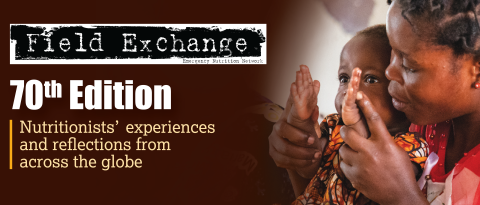Field Exchange 70 Editorial
Dear readers,
Welcome to the 70th edition of Field Exchange. This edition features a diverse range of articles that we hope will stimulate your interest and engagement.
We feature two articles on the theme of classification of nutritional status with implications for admission to appropriate care. There are considerable research and knowledge gaps regarding the optimal maternal mid-upper arm circumference (MUAC) cut-off thresholds to identify poor birth and maternal outcomes. A scoping review by Kapil and Ververs finds that a MUAC cut-off threshold of <23 cm performs well as a screening tool for identifying pregnant women at risk of adverse birth outcomes, particularly low birthweight. For children, findings from Fayyaz et al highlight the impact of imprecise age data recording on classifying malnutrition status according to weight-for-age. Inaccurately rounding ages, even by just a few months, can lead to biased underweight estimates with implications for the identification and optimal treatment of children with the greatest mortality risk. The authors propose several ‘imperfect’ solutions, concluding that ultimately the ubiquitous use of birth certificates may be needed.
Three articles link to the theme of infant and young child feeding. Atuman et al describe how father-to-father support groups were found to have a positive impact on infant and young child feeding practices in northern Nigeria. Despite the promising results, a major challenge was the sustainability of the approach given the context of strong cultural norms and competing priorities of fathers as the main household providers. This limited the scope for continual engagement beyond the programme phase.
An article by Fleming et al presents the results of a study on young children’s feeding practices in mandatory quarantine facilities during the COVID-19 pandemic in Australia. Even in such a high-income country, the provision of optimal young child feeding in this closed emergency setting was woefully inadequate. This indicates that such problems are not necessarily due to resource constraints but, rather, symptomatic of a broader failure to understand and deliver age-appropriate responsive child feeding in such settings. Better uptake of existing infant and young child feeding in emergencies operational guidance is needed alongside the development of clear minimum standards and adequate staff training for the provision of optimal young child feeding in any setting where people are constrained in resourcing their own food, such as protracted and acute crises.
Infant feeding in emergencies remains an under-researched area. A qualitative study by Addison explores practitioners’ perceptions of research priorities concerning infant and young child feeding in emergencies that were outlined in 2016. It finds seven out of 10 of the priorities to still be largely relevant. This article was adapted by the author from her original student dissertation project; we encourage other students to submit their own dissertations for consideration for publication, as part of our commitment to engaging with early career professionals.
With humanitarian crises sadly on the rise, good practice in such contexts remains critically important. The Grand Bargain – an agreement to reform the delivery of humanitarian aid – was launched in 2016 with a key commitment of increasing localisation within humanitarian assistance. Since then, progress towards this commitment remains poor overall.1 Munikwa et al’s article, however, illustrates how encouraging the engagement of local partners and extending their geographical coverage was instrumental in scaling up the nutrition response in a challenging and insecure context in northern Ethiopia. In a letter to the editor, Rahimov et al bring to light the benefits that rationalisation of services has brought to the nutrition response in the Rohingya refugee camps in Cox’s Bazar.
A views piece by Humphreys and Heymsfield challenges us all to look at the way in which we use images of children in our work, particularly in humanitarian contexts, and provides illustrations of better practice. For example, the authors suggest we can use examples from nutrition assessments, where images of children can be replaced with alternatives focused on the work of survey teams and the survey context. We support the view of the authors and provide a short postscript to the article with our reflections.
A publication in our last edition of a cost-efficiency analysis of wasting treatment in Indonesia suggested scale-up efforts should prioritise increasing coverage in high-burden areas. In this edition, analysis from Mali by Lee and Ouedraogo suggests that treating severely wasted children with a simplified protocol may be more cost-efficient than with a traditional protocol.
As usual, we publish an array of research summaries. Among these, we feature the recent Lancet series on small and vulnerable newborns accompanied by an engaging, thought-provoking views article – based on a recent blog post – by Marie McGrath, in response to the Lancet series authors’ call for action.
Three other summaries highlight the current bleak global picture for child malnutrition and food insecurity. Not enough progress has been made in reducing malnutrition across the globe, while the increasing pace of urbanisation is blurring the distinction between urban and rural differences, making it vital that food systems recalibrate to address the new challenges this presents to food insecurity and malnutrition. In the meantime, acute food insecurity is projected to deteriorate further in 22 countries between June and November 2023.
Finally, we also feature a summary of the revised World Health Organization guidelines on the management of acute malnutrition, with more to come on this in the next edition of Field Exchange.
Happy reading!
1 Metcalfe-Hough V, Fenton W & Manji F (2023) The Grand Bargain in 2022: An independent review. HPG commissioned report. www.odi.org/en/publications/thegrand-bargain-in-2022-an-independent-review


